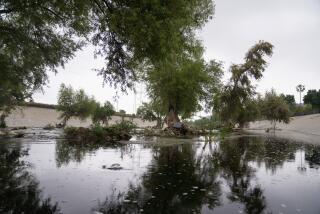Commerce, Culture Join on St. Lawrence River : Canada: The many moods of <i> la mer </i> are found on a trip from the Thousand Islands to the sea. This turnpike for shipping is also a refuge for wildfowl, whales.
- Share via
The icebreaker Pierre Radisson, flagship of the Canadian coast guard’s St. Lawrence River fleet, tosses aside chunks of ice the size of cottages.
Snow, sky and shoreline blur. Filing along behind us in a wintry convoy are the Federal Kumano, a bulk carrier from Manila, a tramp steamer flying a Panamanian flag, a Hong Kong container ship and a Canadian tanker.
The St. Lawrence is a big-shouldered river that can challenge a navigator any time of the year. I would discover this when I returned in summer and chartered a 37-foot cutter to follow the river’s 750-mile course to the sea.
I would find a river of many moods, often sophisticated, occasionally wild and stormy, but never less than majestic.
Short as major rivers go, the St. Lawrence makes up for it in volume; its flow is nearly that of the Rhine, Volga and Nile combined. Its narrowest pinch, under the Quebec City bridge, measures half a mile; crossing the river’s mouth is a voyage of 90 miles. There locals refer to it as la mer , the sea.
The river spills from the eastern edge of Lake Ontario, then snakes northeastward, sketching the frontier between New York state and Canada’s Ontario province. By the time it reaches Montreal, it has dropped 226 feet through the complex of weirs and locks of the St. Lawrence Seaway.
As part of the Great Lakes St. Lawrence Seaway system, the river provides access as far inland as Duluth, Minn. Each year, ships make about 2,300 trips along the river section alone.
I began my summer journey in the Thousand Islands--actually there are about 1,800 of them--which make a patchwork of the river as it leaves Lake Ontario. The islands, some hardly more than large rocks, hold farms, estates and summer cottages that can cost millions of dollars.
On tiny Heart Island, for instance, broods a 120-room castle guarded by gates and turrets. It was built at the turn of the century by George Boldt, wealthy manager of New York’s Waldorf Astoria Hotel. Today it is a tourist attraction.
Entering Quebec Province, the St. Lawrence becomes the Fleuve St.-Laurent, for this is the heart of French-speaking Canada. Guiding my cutter Foxtrot through the final locks of the seaway, I followed the strong currents under arching bridges, noisy with trains and traffic pouring into workaday Montreal.
Always long on originality, Montreal’s more whimsical attractions include the annual boat race organized by sailing instructor Yves Plante. “The rules limit you to $100 (about $75 in the United States) for materials. You have three hours to build your boat,” Plante explained, “then into the water, and the race begins.”
Early Sunday morning, 42 skippers and their crews arrived at the Olympic Basin on Ile Notre-Dame to unload plywood, plastic sheets, cardboard, old barrels and rope. During the busiest three hours I can remember, my crew and I cobbled together a dinghy of rough plywood and rigged it with a spritsail cut from a $6 tarp.
Before a faint breeze, I coaxed our dinghy to the finish line, but well behind the winner, carpenter Alain Guibert’s long, narrow outrigger.
Heavy industry defines much of the upper St. Lawrence. Effluent from scores of paper mills, chemical plants, smelters and refineries has stained its sparkling waters for decades, choking local fish populations and even poisoning the endangered beluga whales hundreds of miles downstream.
Federal and provincial environment ministries began a major effort to clean up the river in 1988, targeting the 50 worst industrial polluters. The program has already cut their toxic dumping by nearly 75%. Yet many environmentalists are not satisfied, claiming that more needs to be done to restore the river to health. Purging the muddy river bottom of heavy metals, they say, will take generations.
Sailing toward Quebec City, Foxtrot danced along the wide river. Next day, docked in the city, I drove to Cap Charles to seek out the home of Delphis Duhamel, now retired from the furniture industry.
“I started this hobby of saluting passing ships in 1964, partly to spark our children’s interest in geography,” Duhamel said when he showed me the breathtaking panorama from his front yard. In lockers around us hung flags of all nations. A weatherproof console protected his tape player and cassettes of 150 anthems.
After Quebec City, the river widens into its broad estuary and shores recede into distant gray lines. Here changeable weather can surprise even a cautious skipper.
The wider river becomes a magnet to wildfowl. You will see colonies of Atlantic puffins along a deserted island cliff or hear the thunderclap of wings as half a million snow geese splash into a gray morning sky.
On Ile aux Lievres, Jean Bedard, a specialist in duck behavior, directs a nonprofit organization, the Societe Duvetnor, which draws its name from the French word duvet, meaning the down of birds.
The lower St. Lawrence is also whale country. Foxtrot slipped now into the crescent harbor of Tadoussac, where Basque whalers worked the waters soon after Jacques Cartier, credited with discovering the river, landed in 1535. A giant Victorian hotel is booked up most summers as the town enjoys a new whaling boom--whale-watching.
More to Read
Sign up for The Wild
We’ll help you find the best places to hike, bike and run, as well as the perfect silent spots for meditation and yoga.
You may occasionally receive promotional content from the Los Angeles Times.






